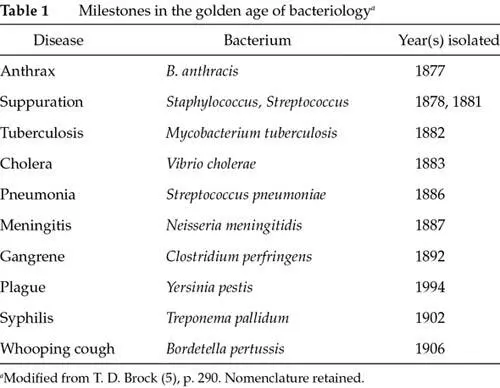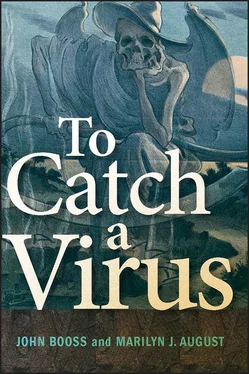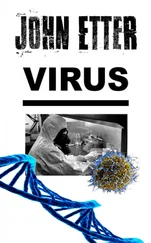doi:10.1128/9781555818586.ch1.f2
In the 19th century, Louis Pasteur laid to rest the magical thinking implicit in an unseen world when he disproved the theory of spontaneous generation. This advance relied on a second crucial innovation: artificial growth medium in which microbes could visibly multiply. Pasteur’s swan-necked flask contained a growth-supportive fluid, which showed turbidity when exposed to the atmosphere and remained clear and uninfected when unexposed. Further, Pasteur’s studies with silkworms established the crucial concept that specific pathological conditions were associated with specific causes—a concept we now take for granted ( 12). After years of experimentation with the silkworm diseases pébrine and flacherie, Pasteur demonstrated their causation and means of prevention by eliminating the offending microbes.
Robert Koch, the genius who laid bare the specific causes of infectious diseases, refined the tools for laboratory diagnosis of infection ( Fig. 3). He markedly facilitated the viewing of microbes through a microscope with the development of a substage condenser, a lens that concentrates light from the source through the object studied. The visualization of microbes was further enhanced through the application of histological stains to differentiate the organelles from other structures in specimens ( 5). With his development of photomicroscopic methods, Koch was able to share his observations, and it was a revelation when his first figures were published.

Figure 3Robert Koch, about 1908. Koch developed the methodology that allowed the emergence of bacteriology as a science. In addition, he isolated the bacteria of tuberculosis and cholera, age-old scourges of humankind. (Courtesy of the National Library of Medicine.)
doi:10.1128/9781555818586.ch1.f3
Koch worked to improve another crucial laboratory tool, solid culture medium. Following the observation of the growth of bacteria on sliced potatoes and with the advice of Fannie Hesse, the wife of a physician working in his lab, Koch incorporated agar into nutrient broth and so created solid medium as a means of selectively growing bacteria ( 4). To this day, the growth and isolation of pure bacterial cultures on agar medium remain the standard of practice for microbiological research and diagnosis.
In his work on tuberculosis, Koch approached the vexing question of etiology. Koch’s postulates had their precedent in the work of Jacob Henle ( 10). While these tenets have evolved over time, Koch’s postulates are usually understood to include the following:
1 Regular isolation of an organism from the diseased organs and absence from healthy organs
2 Growth of the organism in pure culture
3 Recreation of disease on transmission to a susceptible host
4 Reisolation of the offending organism from the experimental host
Once it was possible to demonstrate the growth of microbes on artificial media and to see these microbes microscopically, the determination of the agents of specific infectious diseases simply exploded. These developments heralded the “golden age” of microbiology between 1877 and 1906 ( Table 1). Koch revealed the age-old scourges of civilization, “Asiatic” cholera and consumption (tuberculosis), to be associated with specific organisms. Likewise, staphylococcus and streptococcus were identified as the causes of wound suppuration, limb amputation, and frequently death during wartime and after surgical procedures. A follow-on to the recognition of lethal bacterial wound contamination was Lister’s development of techniques for antiseptic surgery ( 22). The golden age was thus characterized by advances not only in laboratory techniques and demonstration of specific microbial causes of infections but also in the means to prevent those infections.

Birth of Virology, “Filterable Viruses”
Notably absent from the list of infectious diseases were the scourges that we now know as viral diseases. Diseases with telltale skin lesions such as disfiguring smallpox, measles, and the dramatic yellowing of malignant bilious fever or yellow fever did not succumb to isolation attempts on artificial media, nor did rage (rabies), long known for its transmission through the bite of a rabid dog. Fear of these diseases sparked scientists of the day to investigate their etiology and control. Edward Jenner’s revolutionary inoculation of vesicular material from cowpox lesions blunted or prevented dreaded smallpox in recipients. Likewise, Pasteur developed attenuated rabies virus material that he used to inoculate young Joseph Meister, bitten by a vicious, rabid dog. Meister’s miraculous survival unleashed a popular demand for vaccination against this frightful disease ( 12).
Epidemiological studies also fostered an understanding of viral disease even before viruses were actually defined and understood in the laboratory. Such was the case when Peter Ludwig Panum followed the transmission of measles to the Faroe Islands, a group of islands in the North Atlantic Ocean. The consequences of a ship’s carpenter incubating measles and delivering it to the remote Faroe Islands allowed Panum to define the transmission of this viral disease decades before the isolation and demonstration of the virus ( 27). In like manner, the mode of transmission of yellow fever was demonstrated before its characterization as a virus ( 29). That characterization depended on the defining tool of the virology laboratory; oddly enough, it was a filter customarily used to exclude bacteria. So important was that instrument that viruses were long known as “filterable viruses.”
Like Pasteur’s studies of silkworm diseases, the first recognition of viral diseases resulted from commercial urgency: a threat to the tobacco crop by mosaic disease. In 1885, Adolf Mayer demonstrated that infection could be transmitted by sap from diseased to healthy plants ( 24). In 1892, Ivanowski reported to the Academy of Science of St. Petersburg on the mosaic disease of the tobacco plant, “According to my experiments the filtered extract introduced into healthy plants produces the symptoms of the disease just as surely as does the unfiltered sap” ( 20). Independently, Martinus Beijerinck reported in 1898 that the tobacco disease could be transmitted through a porcelain candle filter and that tests for bacteria were negative ( Fig. 4). He characterized the infection as a “ contagium vivum fluidum ,” or contagious living liquid, and suggested that one form could be “. . . a contagium that exists only in living tissues . . .” ( 3). Hence, two laboratory requirements defined viruses: passage through a porcelain filter and the need for living cells on which to grow.

Figure 4Martinus Beijerinck in his laboratory, May 1921. Beijerinck, like Ivanowski, demonstrated that tobacco mosaic disease could be transmitted by sap which had passed through bacteriological filters. He also demonstrated the need for living cells to replicate the disease-causing factor, which he called contagium vivum fluidum. (Photo source: Wikimedia Commons, in the public domain.)
doi:10.1128/9781555818586.ch1.f4
For the first demonstration of a filterable agent in mammals, again the drive was commercial. Foot-and-mouth disease impaired cattle breeding and reduced milk production, bringing severe economic hardship to Prussian agriculture ( 35). Friedrich Loeffler, a collaborator of Koch and the discoverer of the diphtheria bacterium and toxin, was appointed in 1897 by the Prussian Ministry of Cultural Affairs to study foot-and-mouth disease. While readily transmissible experimentally, the agent was not visible microscopically. In collaboration with Paul Frosch, Loeffler demonstrated that foot-and-mouth disease could be transmitted to cows by bacterium-free lymph which had been passed through a Berkefeld filter ( 23). Experiments designed to detect the presence of a toxin resulted in retention of disease-producing activity, even at extremely high dilutions. This observation raised the possibility that the effect was produced by a germ which could multiply. The hope was that a vaccine could be developed. Unfortunately, as discussed by H.-P. Schmiedebach, a vaccine with persistent immunity-inducing capacity did not result, and foot-and-mouth disease remains a scourge to this day ( 35).
Читать дальше















